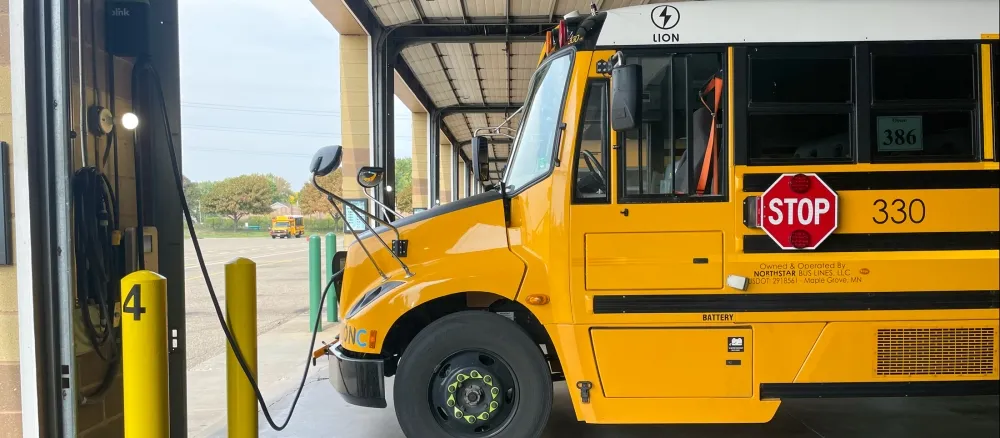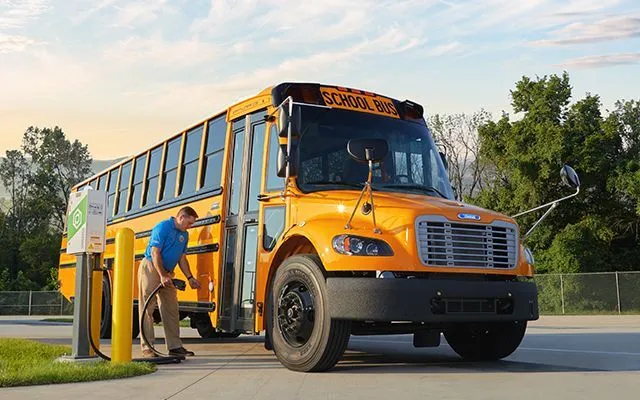
The Mobility House & Schneider Electric Launch Solar Charging Depot for Turlock Unified’s E-Bus Fleet
Turlock Unified School District (TUSD) marked a significant milestone in its journey toward sustainable student transportation with the official unveiling of nine new electric school buses and a state-of-the-art solar-powered charging infrastructure. The achievement was celebrated with a ribbon-cutting ceremony at the district’s transportation center, symbolizing a bold commitment to clean energy and zero-emissions mobility.
The event brought together key stakeholders and partners who played a pivotal role in bringing the project to fruition, including Schneider Electric, The Mobility House, Turlock Irrigation District, A-Z Bus Sales, Valley Air District, and NV5. The collective effort of these organizations enabled TUSD to move one step closer to its overarching goal of transitioning to a fully electric school bus fleet by 2035.
Replacing Diesel with Clean Energy
At the heart of the project are nine Blue Bird electric school buses, which will immediately replace aging diesel-powered vehicles currently in operation. By transitioning away from internal combustion engines, the district is aiming to reduce greenhouse gas emissions, improve air quality for students and the broader community, and decrease maintenance and fuel costs over time.
Each of the new buses is powered by high-efficiency electric drivetrains and supported by a combination of alternating current (AC) and direct current (DC) fast chargers. These chargers are energized, in part, by electricity generated from solar canopies installed over the parking area. The solar structures not only provide energy to charge the buses but also offer much-needed shade, reducing the urban heat island effect in the area.
The chargers are intelligently managed by a cutting-edge charge management system developed by The Mobility House. The software optimizes charging schedules to prioritize the use of solar energy generated on-site while minimizing the draw from the electric grid, especially during peak demand hours. This dual objective ensures that the district benefits from both environmental and financial efficiencies, reducing its carbon footprint while also controlling electricity costs.
A Model for Future-Ready School Districts
“This initiative isn’t just about buying electric buses,” said Greg Hintler, CEO of The Mobility House North America, during the ceremony. “It’s about building a transportation system that aligns with the values of our community and our responsibility to future generations. I am incredibly proud to congratulate Turlock Unified School District on taking this important step toward zero-emissions transportation, powered by zero-emissions energy.”
Hintler emphasized that the integration of solar energy with electric mobility represents a transformative model for how public institutions can lead the transition to cleaner, more sustainable infrastructure. “Solar energy and electric buses are complementary technologies,” he added. “They provide a clear, scalable vision for the future of sustainable school transportation.”
The project reflects a growing trend across California, where school districts are increasingly moving away from fossil fuels in favor of clean alternatives. Driven by state mandates, funding incentives, and community demand for healthier air, electric school bus deployments are accelerating across the state.
Strategic Collaboration Drives Success
The success of the TUSD electrification project is attributed to the district’s proactive approach and its willingness to collaborate with leading technology providers and utility partners. Schneider Electric, known for its expertise in energy management and sustainability, played a central role in designing and implementing the energy infrastructure supporting the electric fleet.
“California school districts like Turlock are leading the way toward our electric future,” said Elliott Feldman, Program Manager at Schneider Electric. “Their ambition and drive to implement sustainable solutions is a testament to the important role they play in their community. Turlock isn’t just talking about sustainability—they’re making it happen.”
The partnership between Schneider Electric and The Mobility House has been instrumental in other successful school bus electrification projects throughout California. Their joint deployments at districts such as Stockton Unified and Modesto City Schools have already demonstrated the feasibility and benefits of zero-emissions school transportation. Additional installations are expected to go live later this summer, further expanding the reach of electric school buses throughout the Central Valley and beyond.
Leveraging Local and Regional Support

The transition to electric school buses at TUSD was made possible in part by funding and support from multiple local and regional agencies. The Turlock Irrigation District, a key utility partner, worked closely with project stakeholders to ensure reliable and sustainable energy delivery for the charging infrastructure.
Meanwhile, the San Joaquin Valley Air Pollution Control District (commonly known as the Valley Air District) played a role in promoting clean air initiatives and supporting transportation electrification efforts that align with regional air quality improvement goals. Their involvement underscores the environmental importance of projects like this, which directly impact public health by reducing localized emissions.
A-Z Bus Sales, the authorized Blue Bird dealer and service provider, was instrumental in supplying the electric buses and ensuring they met the operational requirements of the district. Their continued support in training, service, and maintenance is expected to help TUSD transition smoothly and maximize the life span of its electric fleet.
NV5, a leading engineering and consulting firm, also contributed to the technical planning and project management aspects, helping to ensure the safe and efficient deployment of the infrastructure.
Toward a Greener Tomorrow
The project comes at a time when school districts across the U.S. are under increasing pressure to modernize their fleets and reduce their environmental impact. According to the World Resources Institute, school buses transport more than 25 million children every day in the U.S., with more than 90% of those buses powered by diesel. Electrifying this segment of public transportation could have enormous implications for air quality, carbon emissions, and public health.
Turlock Unified is taking a leadership role by committing to fully electrify its fleet by 2035, setting a clear timeline and investing in the infrastructure necessary to make that goal achievable. With every diesel bus replaced, the district will eliminate thousands of pounds of harmful pollutants annually, including nitrogen oxides, particulate matter, and carbon dioxide.
The solar-powered charging system not only enhances the environmental impact of the project but also makes economic sense. By leveraging clean energy generated onsite, the district can shield itself from volatile energy prices and rising utility rates while reducing operating costs over the long term.
A Blueprint for Other Districts
As other school districts watch the progress at Turlock, the project may serve as a blueprint for how to design, fund, and implement similar initiatives. Key to TUSD’s success has been its focus on long-term planning, strategic partnerships, and commitment to community health and climate responsibility.
By bringing together industry leaders in energy, transportation, and technology, TUSD has demonstrated what’s possible when vision and collaboration come together in pursuit of a common goal.
“Our students deserve to breathe clean air, and our community deserves a future that’s resilient and sustainable,” said a district official. “This is more than just an investment in buses — it’s an investment in our children and in the future of Turlock.”
As the electric buses begin their routes, quietly replacing their diesel predecessors, they signal not only a technological shift but also a cultural one—one where sustainability, innovation, and education move hand in hand toward a better tomorrow.

